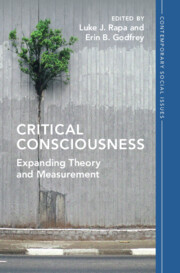Book contents
- Critical Consciousness
- Contemporary Social Issues
- Critical Consciousness
- Copyright page
- Dedication
- Contents
- Figures
- Tables
- Contributors
- Acknowledgments
- Introduction Critical Consciousness Theory and Measurement
- Part I Theory
- 1 Synthesizing Critical Consciousness and Identity-Based Motivation to Clarify How Youth of Color Navigate and Challenge Racial Capitalism
- 2 Situating Critical Consciousness Within the Developmental System
- 3 Integrating Critical Consciousness and Social Empathy
- 4 Critical Consciousness in Early to Middle Childhood
- 5 Adolescents’ Developmental Pathways to Critical Consciousness in the Contexts of Racial Oppression and Privilege
- 6 Making Reflection Critical
- Part II Measurement
- Conclusion Expanding Critical Consciousness Theory and Measurement
- Index
- References
4 - Critical Consciousness in Early to Middle Childhood
from Part I - Theory
Published online by Cambridge University Press: 20 April 2023
- Critical Consciousness
- Contemporary Social Issues
- Critical Consciousness
- Copyright page
- Dedication
- Contents
- Figures
- Tables
- Contributors
- Acknowledgments
- Introduction Critical Consciousness Theory and Measurement
- Part I Theory
- 1 Synthesizing Critical Consciousness and Identity-Based Motivation to Clarify How Youth of Color Navigate and Challenge Racial Capitalism
- 2 Situating Critical Consciousness Within the Developmental System
- 3 Integrating Critical Consciousness and Social Empathy
- 4 Critical Consciousness in Early to Middle Childhood
- 5 Adolescents’ Developmental Pathways to Critical Consciousness in the Contexts of Racial Oppression and Privilege
- 6 Making Reflection Critical
- Part II Measurement
- Conclusion Expanding Critical Consciousness Theory and Measurement
- Index
- References
Summary
The literature on critical consciousness (CC) has seen rapid growth in the past ten years. However, the literature has given very little attention to CC in preadolescent children. In this chapter, we contend that the sociopolitical and civic elements of early to middle childhood development have been understudied. Emphasizing the familial, social, and educational systems that structure the lives of young children, we elaborate on the evidence that young children hold the capacity for understanding social inequities, becoming empowered to work for social change, and acting against injustice, and we provide concrete examples of how CC might be identified and measured at different stages of the early childhood developmental period. In addition, we show that the structural emphasis of the CC literature and related literatures (e.g., work on critical race theory) adds much-needed context to the study of bias and stereotyping in early childhood.
- Type
- Chapter
- Information
- Critical ConsciousnessExpanding Theory and Measurement, pp. 88 - 119Publisher: Cambridge University PressPrint publication year: 2023

